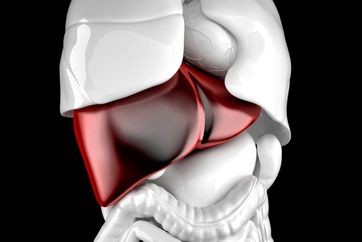Weight loss mediates CV damage of fatty liver in diabetes
PHILADELPHIA — Nonalcoholic fatty liver disease is an “unrecognized epidemic” among people with type 2 diabetes, according to a speaker at the Heart in Diabetes conference.

Nonalcoholic fatty liver disease (NAFLD) is directly correlated with cardiometabolic abnormalities, and sustained weight loss can reduce the risk for incident cardiovascular events in patients with the condition, Samuel Klein, MD, the William H. Danforth professor of medicine and nutritional science and director of the Center for Human Nutrition at Washington University School of Medicine, said during his presentation.
“Both NAFLD and coronary heart disease represent end-organ manifestations of the same systemic metabolic insult, primarily related to insulin resistance,” Klein told Endocrine Today. “NAFLD and CVD are part of the constellation of metabolic abnormalities associated with obesity, and more people who have NAFLD die from CVD than from liver disease.”
As obesity develops so do metabolic complications, including NAFLD and its more severe stage, nonalcoholic steatohepatitis (NASH), atherogenic dyslipidemia, prediabetes and type 2 diabetes — all important risk factors for CVD, Klein said.
NAFLD is defined as more than 5.6% of liver volume made up of triglycerides located inside of liver cells, and about 34% of adults in the U.S. and 70% of people with type 2 diabetes have NAFLD, he said. However, very few patients with fatty liver alone will go on to develop NASH. Of those with NASH, about 20% will develop cirrhosis, according to Klein.

“We have no idea who with NAFLD will develop NASH and who with NASH will develop cirrhosis,” Klein said. “But even though only a small percentage of people with steatosis will ultimarely develop serious liver disease, the number is still large because so many people have steatosis. About 2 million people have cirrhosis caused by NAFLD in the U.S. Some have silent compensated cirrhosis and do not even know it.”
NAFLD as risk factor
The more liver fibrosis a patient has, the greater the mortality risk, Klein said. Progression across stages of fibrosis takes a long time — on average, progressing one stage every 7 years, Klein said, although a subgroup of people with NAFLD are what he called “rapid progressors.”
“The main cause of death is CVD, not liver disease,” Klein said. “Only when you get to cirrhosis do you see a big spike in death from liver disease. When you have cirrhosis, about 50% of the deaths are attributed to liver disease, so half die from non-liver disease causes.”
Klein said NAFLD is “clearly a risk factor” for developing cardiometabolic abnormalities, noting that one-third of people with NAFLD have metabolic syndrome, and 90% have at least one component of metabolic syndrome criteria. In a Mayo Clinic study that looked at the incidence of cardiometabolic disease over 5 to 7 years in people with NAFLD, 25% died from CVD, and similar percentages of people developed type 2 diabetes, dyslipidemia and hypertension, Klein said.
“Fatty liver tracks with cardiometabolic abnormalities,” Klein said. “The more severe the fatty liver, the more severe the atherosclerosis.”
One major risk factor for CVD that is associated with fatty liver is an increase in blood triglyceride concentration, which Klein called an important marker for increased fat in the liver.
“We know that VLDL triglyceride, which is made by the liver and is a major source of triglyceride in the bloodstream, is an important risk factor for heart disease,” Klein said. The rate of hepatic VLDL triglyceride secretion in people who are obese with NAFLD are twice as high as people who are obese with normal liver fat content, he said.
Increased fat in the liver is associated with insulin resistance in adipose tissue and muscle tissue and the liver and also with multi-organ systemic insulin resistance, Klein said.
Fatty liver is increasingly observed in adolescents who are obese, Klein said. In a study of lean adolescents and adolescents with obesity, Klein and colleagues observed that increased liver fat seen in teens with obesity was associated with increased triglycerides in the heart, he said.
“These are children who have routine blood tests in the normal range, so their physician can’t tell who has fatty liver,” Klein said. “Addressing this problem early in life will have the best effect vs. later in life.”
Importance of weight loss
Weight loss reduces liver fat content and NASH has been shown to improve CV structure and function, including early diastolic and systolic myocardial velocity, left ventricular mass and carotid intima-media thickness, Klein said.
“Fatty liver disease, chronic kidney disease, cardiovascular disease, diabetes are all organ damages responding to a systemic metabolic insult,” Klein said. “A lot of us look at these different organ systems independently and forget to consider the simultaneous biological dysfunction systems biology of all multiple organs, which are caused by obesity.” – by Regina Schaffer
Reference:
Klein S. Impact of obesity on liver and the heart. Presented at: Heart in Diabetes CME Conference; July 12-14, 2019; Philadelphia.
Disclosure: Klein reports he holds stock in Aspire Bariatrics and has received research support from Centene, Janssen and Pershing Square Foundation, consultant fees from Dannon-Yakult, Lobesity, Merck, Novo Nordisk and Pfizer and endowments from the Atkins Philanthropic Trust and the Kilo Foundation.


